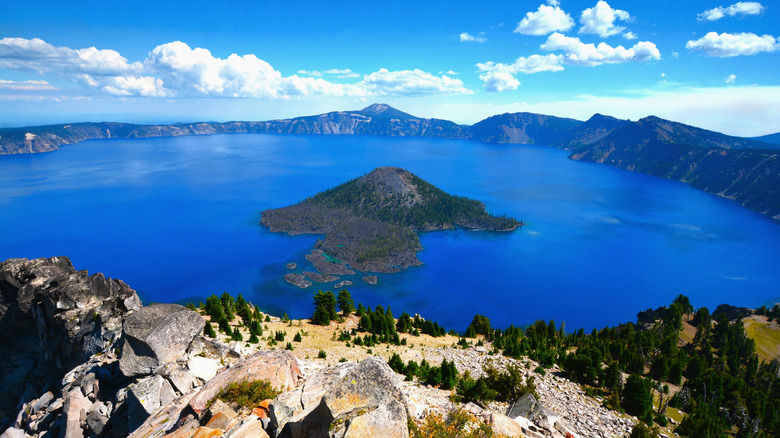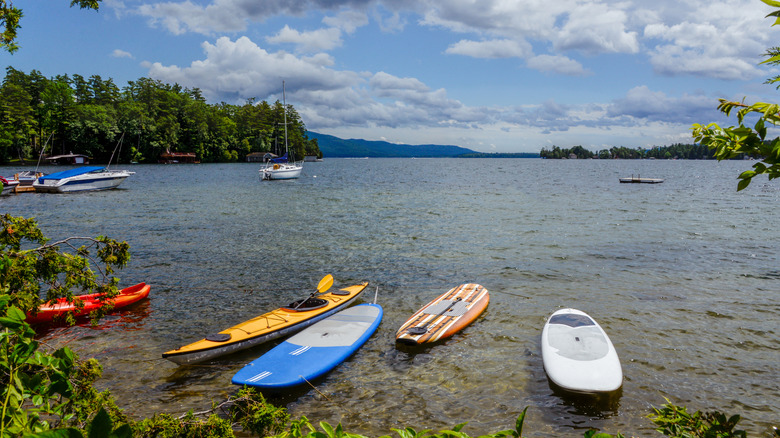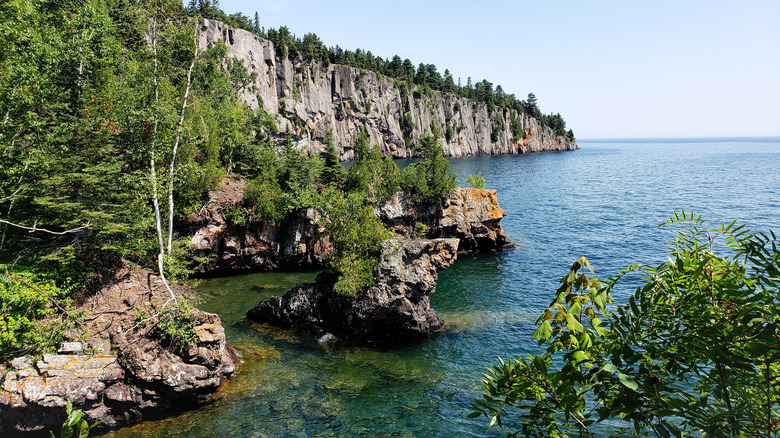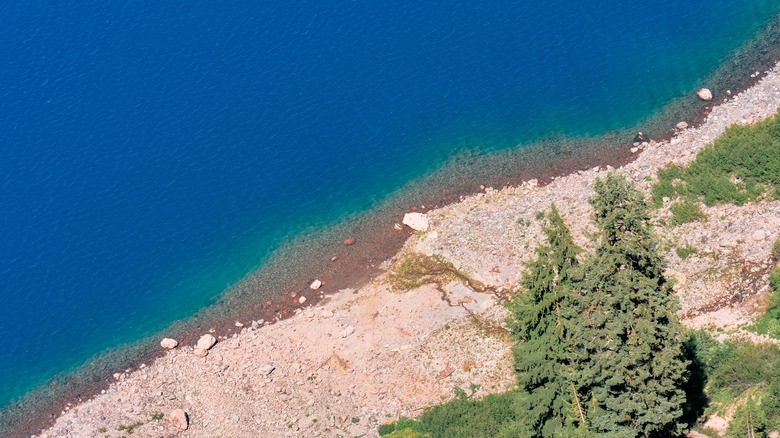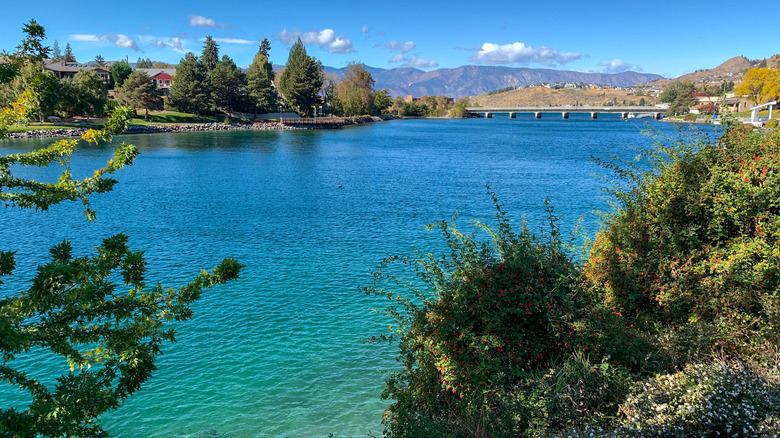America's Clearest Lakes Where You Can See All The Way To The Bottom (Other Than Tahoe)
They call Lake Tahoe the Big Blue, but it could just as well be called the 'Big See-Through Thing,' because the third-deepest and largest alpine lake in North America is undoubtedly among the clearest lakes on the planet. What's more, there are reports that it's at its clearest for nearly four decades right about now. You could say there's never been a better time to do those picturesque Lake Tahoe road trips or hit the best lake beaches for spectacular sunsets.
But it's also worth remembering that there are plenty of other lakes in the U.S. The stats reveal that there are nearly half a million lakes in the Lower 48 alone. Heck, the state of Minnesota — a place they call the 'Land of 10,000 Lakes' — actually counts over 14,000 individual lakes, while California has over 3,000 named lakes. On top of that, there are stacks of waters that might just be able to give Tahoe a run for its money on the clarity front.
Not just content with having tons of other lakes, America the Beautiful has tons of uber-clear lakes, just like the fabled Big Blue itself. They run the gamut from forest-fringed waters in the peaks of the Empire State's Adirondacks to teal-tinged glacier lakes over in the Evergreen State. Some are harder to reach than others, but all promise one thing: H2O that's so darn clear you'll almost be able to see the bottom!
Lake George, New York
Lake George is a name that gets mentioned time and time again when it comes to the clearest lakes in the USA. In fact, Travel + Leisure recently reported that this one had been crowned the cleanest lake in the whole of the United States, beating even California's beloved Tahoe on the water quality front, while USA Today placed it among the top three lake vacation spots in the country.
It's certainly got the location. Long, thin Lake George spreads for 32 miles through the midst of New York's Adirondack Mountains, with huge sweeps of untouched forest rolling up and down the banks. Way back in the 1800s, it became one of the first official vacation destinations on the continent when adventurers came up from the Big Apple to hunt, fish, and ride steamboats across its surface.
Today, Lake George remains a fine place to escape the hubbub of the metropolis. For water babies, it's perfect. Everything from jet skis to tubes, kayaks to traditional sailboats can be organized in these parts, on a lake that's got the highest possible cleanliness rating in the state.
Lake Superior, Minnesota, Wisconsin, and Michigan
Lake Superior is superlative in both name and nature, it seems. A recent study by Lake.com put it in tip-top place in a ranking of the cleanest lakes in the country. The technical stuff? A low turbidity rating of just 0.46, zero out of 10 pollution metrics, and just 0.01 milligrams of ammonia per liter. To put it another way: It's clean — very clean. The cleanest lake in America, you could say.
The largest of the Great Lakes, Superior encompasses a colossal 31,000 square miles of territory, spilling across three different states and two different nations (a bit of its northern half sits across the border into Canada). It's deep, too — this shimmering shock of blue in the Midwest goes down a spine-tingling 1,332 feet at its lowest point.
The huge size means there are plenty of places to come and enjoy the average 27-foot underwater visibility offered by Lake Superior. Lovely towns like Minnesota's Grand Marais offer up boat-bobbing marinas and vintage lighthouses. Meanwhile, adventurers can cruise the Lake Superior Circle Tour, a 1,300-mile touring route that links beaches, clifftop viewpoints, hiking paths, and charming waterside towns aplenty.
Crater Lake, Oregon
More superlatives flow at Crater Lake, Oregon's sparkling gem in the sky. This is the official deepest lake in the United States, with a bottom that's almost 2,000 feet below its surface. You won't be able to peer quite that far into old Crater, though, since average visibility here is around 100 feet down, slightly more than the average visibility you get at Tahoe. Apparently, it's due to the fact that Crater Lake is fed only by snowmelt, keeping things as clear as clear can be.
And then there's the setting. It's jaw-dropping, eye-popping, goosebump-raising stuff. Carved out of a huge mountain atop the main ridge of the Oregon Cascades, the volcanic basin that Crater Lake sits in is a symphony of soaring cliffs and rocky islands. It's now the centerpiece of a national park where you can hike to secret swimming spots, ferret out waterfalls amid the Willamette National Forest, and wonder at wildflower displays on the rim trails.
Crater Lake is open all year round, but you'll want to time it right if you've come to appreciate the sheer shimmer of the water. Snow and ice can obscure the lake surface in the winter, while cloud coverage will also hinder the view.
Lake Chelan, Washington
The final mention on our selection of uber-clear U.S. lakes comes in the form of long, thin, snaking Lake Chelan of Washington State. The product of ancient geological movements in the North Cascades, it's a 50-mile run of glacier-origin water that's cold, crisp, and ridiculously clear. In fact, it's so clear that Chelan is now classified as an ultra-oligotrophic lake, which means very low concentrations of algae and organisms, just like in Tahoe.
What's particularly impressive is that Chelan's chart-topping water clarity has remained relatively stable over the years. Measurements taken back in the early 2000s showed that it was possible to gaze nearly 60 feet down into the water from the surface, only slightly better than today's 50 feet.
Adding yet more allure to the situation is the fact that Lake Chelan is a world-class wine and adventure destination. By morning, head out on your kayak to enjoy the sunrise over a glass-clear lake surface. By evening, settle in for some fine wines at one of the 40 local wineries that craft award-winning labels thanks to the regional microclimate offered by the lake.
